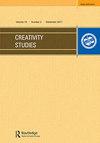PERCEPTION OF CREATIVE IDENTITIES BY ARTISTIC AND NON-ARTISTIC INDIVIDUALS: CONSEQUENCES FOR MANAGEMENT
Q1 Social Sciences
引用次数: 1
Abstract
The interdisciplinary research on the perception of creative identities like artists, creators,entrepreneurs, leaders, and managers brings substantial conclusions for understanding the way of thinking, internal features, and motivations of decisions of individuals with and without artistic factor. For this purpose, an international quantitative examination of 160 individuals was undertaken. The research exhibited that individuals with and without artistic identity perceive artists, creators, entrepreneurs, leaders, and managers statistically similar (chi-square test of independence used, p < 0.001). The negative verification of the hypotheses was astonishing and a novelty in the investigated area. The novelty should be seen as an artistic potential existing in each individual. The additional qualitative analysis of the 50 features constituting the investigated identities revealed that individuals with and without artistic identity see particular features of these identities slightly differently (the most important, the least important, and the most equally perceived features were described in detail). The outcomes were discussed with the literature on the subject, confirming most other researchers’ theses and revealing some contradictions and can be used to understand the qualities of artistic identity and the perception of investigated identities by individuals, groups, and societies dominated by persons with and without artistic factors. The applicability of the results is broad, mainly due to the role of artistry in today’s world as potential laying in every individual. Specific triggers should be catalyzed instead of looking for artist-born individuals. The education process of artists should focus on revealing artistic potential underlining the role of inspiration, and discovering the motifs of artistic activity.艺术和非艺术个体对创造性身份的感知:对管理的后果
对艺术家、创作者、企业家、领导者和管理者等创造性身份感知的跨学科研究为理解有艺术因素和没有艺术因素的个人的思维方式、内部特征和决策动机带来了实质性结论。为此,对160人进行了国际定量检查。研究表明,具有和不具有艺术身份的个人认为艺术家、创作者、企业家、领导者和管理者在统计学上相似(使用独立性卡方检验,p<0.001)。对这些假设的负面验证令人惊讶,在调查领域是一个新事物。新颖性应该被看作是每个人身上存在的一种艺术潜力。对构成调查身份的50个特征的额外定性分析表明,具有和不具有艺术身份的人对这些身份的特定特征的看法略有不同(详细描述了最重要、最不重要和最平等的感知特征)。研究结果与该主题的文献进行了讨论,证实了大多数其他研究人员的论文,并揭示了一些矛盾,可用于理解艺术身份的性质,以及由具有和不具有艺术因素的人主导的个人、群体和社会对所调查身份的感知。研究结果的适用性很广,主要是因为艺术在当今世界中的作用是每个人都有潜力。特定的触发因素应该被催化,而不是寻找艺术家出生的个体。艺术家的教育过程应注重发掘艺术潜力,强调灵感的作用,发掘艺术活动的主题。
本文章由计算机程序翻译,如有差异,请以英文原文为准。
求助全文
约1分钟内获得全文
求助全文
来源期刊

Creativity Studies
Social Sciences-Cultural Studies
CiteScore
3.20
自引率
0.00%
发文量
38
审稿时长
15 weeks
期刊介绍:
Creativity Studies accepts original research articles with a focus on communication within the creative society. The journal welcomes contributions from scholars from diverse disciplines such as philosophy, sociology, history, political, communication and information sciences. Creativity Studies also publishes survey papers and descriptions of academic events in this area. The journal issues will be organized around different issues on creativity.
 求助内容:
求助内容: 应助结果提醒方式:
应助结果提醒方式:


